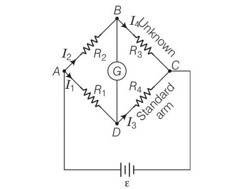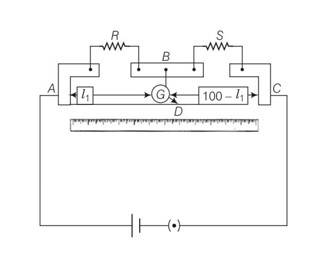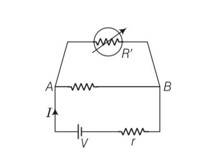Electricity
Get insights from 73 questions on Electricity, answered by students, alumni, and experts. You may also ask and answer any question you like about Electricity
Follow Ask QuestionQuestions
Discussions
Active Users
Followers
New answer posted
6 months agoContributor-Level 10
This is a Multiple Choice Questions as classified in NCERT Exemplar
Answer – (a, c)
Explanation- In case of meter bridge, the resistance wire AC is 100 cm long. Varying the position of tapping point B, bridge is balanced. If in balanced position of bridge AB = l, BC = (100 – l) so that Q/P= (100-l)/l. Also P/Q=R/S=>S= (100-l)/l R
When there is no deflection in galvanometer there is no current across the galvanometer, then points B and D are at same potential. That point at which galvanometer shows no deflection is called null point, then potential at B and neutral point D are same. When the jockey contacts a point on the meter wire to
New answer posted
6 months agoContributor-Level 10
Answer – (b, c)
Explanation – According to the relation that p/q=r/s if galvanometer shows no deflection. In the above equation the value of R4 depends upon R1 and R2 . if the value of R1 and R2 will be feeble the value of R4 would be affected.

New answer posted
6 months agoContributor-Level 10
This is a Multiple Choice Questions as classified in NCERT Exemplar
Explanation- according to the relation = also T
New answer posted
6 months agoContributor-Level 10
This is a Multiple Choice Questions as classified in NCERT Exemplar
Answer – (a, d)
Explanation- potential drop across AB is independent to R' also when we decrease the value of R the current will also very large. According to the relation I=e/R+r
New answer posted
6 months agoContributor-Level 10
This is a Multiple Choice Questions as classified in NCERT Exemplar
Answer – (b, d)
Explanation-Algebraic sum of the currents flowing towards any point in an electric network is zero. It also tell us about the conservation of charge.
New answer posted
6 months agoContributor-Level 10
This is a Multiple Choice Questions as classified in NCERT Exemplar
Answer- (a)
Explanation- I=AneVd , current is directly proportional to drift velocity.
New answer posted
6 months agoContributor-Level 10
This is a Multiple Choice Questions as classified in NCERT Exemplar
Answer- (a)
Explanation- R= for greater value of R, A should be less and its possible value when connected across 1cm 1/2cm faces.
New answer posted
6 months agoContributor-Level 10
This is a Multiple Choice Questions as classified in NCERT Exemplar
Answer- (b)
Explanation-The potential drop along the wires of potentiometer should be greater than emfs of cells.
In a potentiometer experiment, the emf of a cell can be measured if the potential drop along the potentiometer wire is more than the emf of the cell to be determined. Here, values of emfs of two cells are given as 5 V and 10 V, therefore, the potential drop along the potentiometer wire must be more than 10 V.
New answer posted
6 months agoContributor-Level 10
This is a Multiple Choice Questions as classified in NCERT Exemplar
Answer – (c)
Explanation – R/S= (l1/100-l1)= 100 (2.9/100-2.9)= 100/97.1=2.98ohm
So he should change S to almost 3 ohm and repeat the experiment.
Taking an Exam? Selecting a College?
Get authentic answers from experts, students and alumni that you won't find anywhere else
Sign Up on ShikshaOn Shiksha, get access to
- 65k Colleges
- 1.2k Exams
- 681k Reviews
- 1800k Answers


